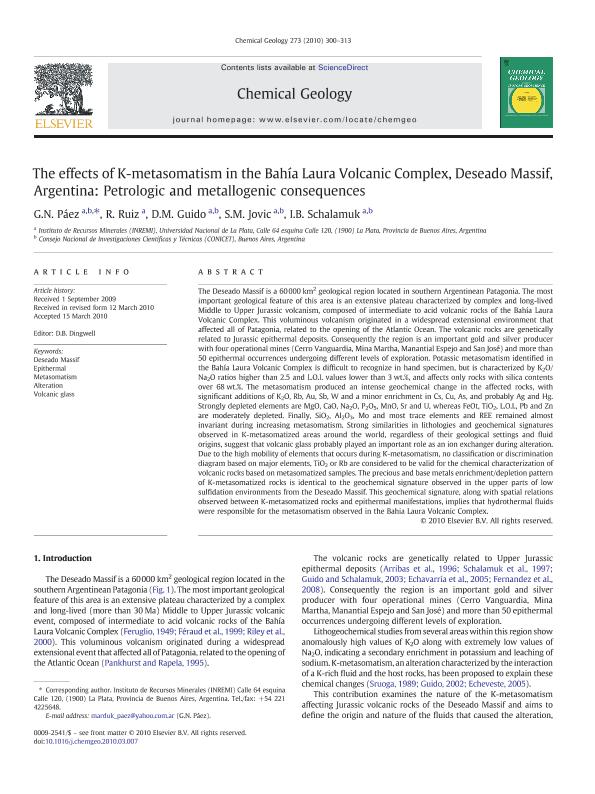Artículo
The effects of K-metasomatism in the Bahía Laura Volcanic Complex, Deseado Massif, Argentina: Petrologic and metallogenic consequences
Paez, Gerardo Nestor ; Ruiz, Remigio
; Ruiz, Remigio ; Guido, Diego Martin
; Guido, Diego Martin ; Jovic, Sebastian Miguel
; Jovic, Sebastian Miguel ; Schalamuk, Bernardo Isidoro
; Schalamuk, Bernardo Isidoro
 ; Ruiz, Remigio
; Ruiz, Remigio ; Guido, Diego Martin
; Guido, Diego Martin ; Jovic, Sebastian Miguel
; Jovic, Sebastian Miguel ; Schalamuk, Bernardo Isidoro
; Schalamuk, Bernardo Isidoro
Fecha de publicación:
02/2010
Editorial:
Elsevier Science
Revista:
Chemical Geology
ISSN:
0009-2541
Idioma:
Inglés
Tipo de recurso:
Artículo publicado
Clasificación temática:
Resumen
The Deseado Massif is a 60000km2 geological region located in southern Argentinean Patagonia. The most important geological feature of this area is an extensive plateau characterized by complex and long-lived Middle to Upper Jurassic volcanism, composed of intermediate to acid volcanic rocks of the Bahía Laura Volcanic Complex. This voluminous volcanism originated in a widespread extensional environment that affected all of Patagonia, related to the opening of the Atlantic Ocean. The volcanic rocks are genetically related to Jurassic epithermal deposits. Consequently the region is an important gold and silver producer with four operational mines (Cerro Vanguardia, Mina Martha, Manantial Espejo and San José) and more than 50 epithermal occurrences undergoing different levels of exploration. Potassic metasomatism identified in the Bahía Laura Volcanic Complex is difficult to recognize in hand specimen, but is characterized by K2O/Na2O ratios higher than 2.5 and L.O.I. values lower than 3wt.%, and affects only rocks with silica contents over 68wt.%. The metasomatism produced an intense geochemical change in the affected rocks, with significant additions of K2O, Rb, Au, Sb, W and a minor enrichment in Cs, Cu, As, and probably Ag and Hg. Strongly depleted elements are MgO, CaO, Na2O, P2O5, MnO, Sr and U, whereas FeOt, TiO2, L.O.I., Pb and Zn are moderately depleted. Finally, SiO2, Al2O3, Mo and most trace elements and REE remained almost invariant during increasing metasomatism. Strong similarities in lithologies and geochemical signatures observed in K-metasomatized areas around the world, regardless of their geological settings and fluid origins, suggest that volcanic glass probably played an important role as an ion exchanger during alteration. Due to the high mobility of elements that occurs during K-metasomatism, no classification or discrimination diagram based on major elements, TiO2 or Rb are considered to be valid for the chemical characterization of volcanic rocks based on metasomatized samples. The precious and base metals enrichment/depletion pattern of K-metasomatized rocks is identical to the geochemical signature observed in the upper parts of low sulfidation environments from the Deseado Massif. This geochemical signature, along with spatial relations observed between K-metasomatized rocks and epithermal manifestations, implies that hydrothermal fluids were responsible for the metasomatism observed in the Bahia Laura Volcanic Complex.
Palabras clave:
ALTERATION
,
DESEADO MASSIF
,
EPITHERMAL
,
METASOMATISM
,
VOLCANIC GLASS
Archivos asociados
Licencia
Identificadores
Colecciones
Articulos(CCT - LA PLATA)
Articulos de CTRO.CIENTIFICO TECNOL.CONICET - LA PLATA
Articulos de CTRO.CIENTIFICO TECNOL.CONICET - LA PLATA
Citación
Paez, Gerardo Nestor; Ruiz, Remigio; Guido, Diego Martin; Jovic, Sebastian Miguel; Schalamuk, Bernardo Isidoro; The effects of K-metasomatism in the Bahía Laura Volcanic Complex, Deseado Massif, Argentina: Petrologic and metallogenic consequences; Elsevier Science; Chemical Geology; 273; 3-4; 2-2010; 300-313
Compartir
Altmétricas



